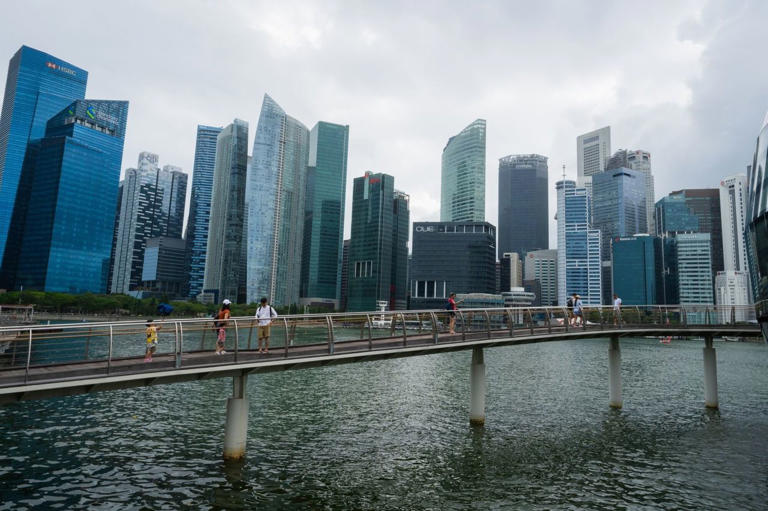Singapore’s economic outlook has taken a turn for the better, as the city-state’s Ministry of Trade and Industry (MTI) updates its growth forecast for the year. The MTI now expects Singapore’s economy to grow between 2.0% and 3.0% in 2024, an upward revision from the earlier forecast range of 1.0% to 3.0%. This positive adjustment is attributed to the resilience in external demand and a notable recovery in the electronics sector, despite facing global economic uncertainties. This revised forecast highlights Singapore’s ability to weather economic challenges and capitalize on its strengths.
Second Quarter Economic Performance
Recent data reveals that Singapore’s economy expanded by 2.9% in the second quarter of 2024 compared to the same period in the previous year. This growth rate aligns with the advance estimate released in July and slightly lags behind the 3.0% growth observed in the first quarter. For the first half of the year, the average growth rate was a stable 3.0%, reflecting a consistent economic performance despite external pressures.
Sectoral Contributions and Challenges
The growth in the April-to-June period was predominantly driven by the wholesale trade, finance & insurance, and information & communications sectors. These areas have shown robust performance and significantly contributed to the overall economic expansion. However, the manufacturing sector, a crucial component of Singapore’s economy, faced challenges due to a sharp decline in the pharmaceuticals segment. On the upside, the electronics sector experienced a rebound, supported by strong demand for smartphones, personal computers, and AI-related chips. This sector’s recovery is a positive sign for Singapore’s economy, given its pivotal role.
Global and Domestic Economic Influences
The MTI acknowledged that while Singapore’s external demand outlook remains resilient, the global economic environment presents ongoing risks. The trade-dependent nature of Singapore’s economy makes it particularly vulnerable to fluctuations in global economic conditions. A potential challenge includes a slight slowdown in the U.S. economy, which could affect consumption growth and subsequently impact Singapore’s trade. Despite this, growth in other advanced economies, such as the European Union and Japan, is expected to accelerate, potentially mitigating some of these risks.
Regional Economic Dynamics
In Asia, Singapore’s major trading partners are experiencing mixed economic conditions. China, a key trade partner, is anticipated to face a slight slowdown in investment growth in the latter half of the year. However, government support measures are expected to stabilize the property market, which may boost consumer sentiment. Meanwhile, Southeast Asian economies are projected to see a modest uptick in growth, driven by strengthening domestic demand and recoveries in global electronics and tourism sectors. These regional dynamics are crucial for Singapore’s trade-dependent economy.
Risks and Potential Headwinds
Several risks could dampen Singapore’s economic momentum. Geopolitical tensions and trade conflicts remain significant threats, potentially impacting business sentiment and increasing production costs. Additionally, disruptions in the global disinflation process could lead to prolonged high interest rates and heightened market volatility. These factors could affect Singapore’s manufacturing sector, although a gradual recovery is anticipated, with electronics showing promising growth prospects.
Quarterly Economic Indicators and Performance
On a quarter-over-quarter basis, Singapore’s GDP grew by 0.4% in the second quarter, matching the advance estimate and maintaining the same growth rate as in the first quarter. This consistency in quarterly performance underscores the stability of the Singaporean economy, despite facing external challenges.
Trade Performance and Future Outlook
Enterprise Singapore reported a 10% year-on-year increase in total merchandise trade in the second quarter, a notable improvement from the 4.8% growth recorded in the first quarter. However, non-oil domestic exports (NODX) declined by 6.4% in the second quarter, widening the 3.4% decrease observed in the previous quarter. The decline in NODX was primarily due to reduced pharmaceutical shipments, although the electronics sector showed its first growth in eight quarters.
Forecasts for Trade and Exports
Looking ahead, Enterprise Singapore anticipates that total trade will benefit from high oil prices and a recovery in electronics, particularly in AI servers and consumer devices. The forecasts for 2024 have been revised to reflect this outlook, with total merchandise trade expected to grow by 5.0% to 6.0%, and NODX projected to increase by 4.0% to 5.0%. These revised forecasts indicate a cautiously optimistic view for Singapore’s trade performance in the coming year, highlighting the expected recovery in key sectors.
Conclusion and Strategic Outlook
Singapore’s updated growth forecast reflects a balanced view of its economic prospects, acknowledging both the resilience in key sectors and the challenges posed by global economic uncertainties. The city-state’s strategic adjustments and sectoral recoveries will play a significant role in shaping its economic future. As Singapore continues to navigate the evolving global landscape, its ability to adapt and leverage its strengths will be crucial in maintaining economic stability and growth.
